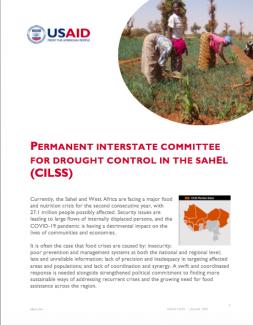Currently, the Sahel and West Africa are facing a major food and nutrition crisis for the second consecutive year, with 27.1 million people possibly affected. Security issues are leading to large flows of internally displaced persons, and the COVID-19 pandemic is having a detrimental impact on the lives of communities and economies.
It is often the case that food crises are caused by: insecurity; poor prevention and management systems at both the national and regional level; late and unreliable information; lack of precision and inadequacy in targeting affected areas and populations; and lack of coordination and synergy. A swift and coordinated response is needed alongside strengthened political commitment to finding more sustainable ways of addressing recurrent crises and the growing need for food assistance across the region.
CILSS works together with different actors to help prevent severe food shortages, loss of lives and livelihoods. Through the Cadre Harmonizé for the Identification of Risk Areas and Vulnerable Populations and the Regional Mechanism for Food Crisis and Management in the Sahel and West Africa (PREGEC), food and nutrition security is monitored so that member states can ascertain the right mix of assistance in a timely manner when tackling the effects of food and nutrition insecurity. Early warning systems are also helping member states to manage their response to food crises in a more effective way than before, to put in place food risk mitigation measures, and mobilize security stocks of food and non-food items.
PROGRAM COMPONENTS
CILSS, headquartered in Ouagadougou, invests in research for food and nutritional security and the fight against the effects of desertification and climate change in the Sahel and West Africa. As a technical arm of the Economic Community of West African States (ECOWAS), CILSS monitors the food and nutrition security in 17 Sahelian and West African countries, runs a large satellite data centre, and operationalizes a proven protocol that countries follow in collecting their food-security data.
CILSS also operates a regional training centre in Niamey, Niger, where agronomists, weather and livestock specialists and technicians pursue their education. Known as AGRHYMET – for the agriculture, hydrology and meteorology courses taught there – its curriculum includes courses in natural resource management, climate change adaptation and plant protection.
CILSS’ other specialized institution, the Institut du Sahel (INSAH), based in Bamako, Mali, supports research on agriculture, biosecurity, population, pesticides, seeds, climate change and markets.
Program Information
Goal: To monitor food and nutrition security so that member states can ascertain the right mix of assistance.
Life of Program: March 2016 to February 2023
Total USAID Funding: $16.8 million
Geographic Focus: At the time of its creation, CILSS had nine member countries. Following the solidification of its association with ECOWAS in 2004, CILSS modified its focus to include all 15 of ECOWAS member states plus Chad and Mauritania. Thus, it currently covers 17 countries: Benin, Burkina Faso, Cabo Verde, Chad, Côte d’Ivoire, Gambia, Ghana, Guinea, Guinea Bissau, Liberia, Mali, Mauritania, Niger, Nigeria, Senegal, Sierra Leone and Togo.
Implementing Partner: CILSS
Regional Partners: World Bank, United Nations Development Program (UNDP), International Fund for Agriculture Development (IFAD), African Development Bank (AfDB), Islamic Development Bank (IsDB), European Union (EU)

